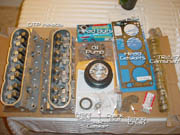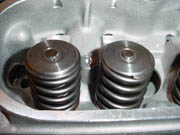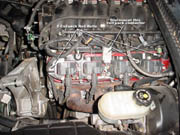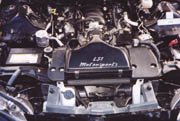

| Tools Needed: |
- Set of metric sockets, deep and normal (from 8mm to 19mm is good) - Set of Metric wrenches (8mm, 10mm, 13mm, 15mm, 18mm, 19mm) - Metric "Gear" wrenches (not absolutely necessary, but REALLY handy) - 8mm hex allen wrench - Torque wrench for 20lb/ft up to 150+lb/ft - Various socket extensions, ranging from 3" to 12" - Medium length socket wrench - Large 1/2" drive breaker bar - Piece of pipe to slip over breaker bar handle - 1/2" drive 24mm socket - Adapter from 1/2" drive to 3/8" drive - 3 armed pulley puller - Felt tipped marker (if using stock headbolts) - Plastic ice scraper - Prybar or large flathead screwdriver - Medium sized pliers (for hose clamps) - Medium sized flat head screwdriver - 3/8" fuel line disconnect tool - 3+ gallon Bucket - Optional: Flywheel locking tool (for automatic transmission cars only) - Optional: Longer crankshaft pulley bolt (Size specs coming soon) |
| Parts/supplies you will need: |
Parts: - 2 LS1/LS6 engine heads - 1 Camshaft - Optional: Underdrive crank pulley - Optional: blueprinted oil pump - Optional: New timing chain - Optional: New OEM 2001 style intake manifold Bolts/gaskets: - 2 GM headbolt kits (2x GMPN 12498545) - OR ARP head bolts or head studs - For 97-01' style heads, buy 1 pair of headgaskets (1x GMPN 12498543) - For 02-03' style heads, buy 1 pair of headgaskets (1x GMPN 12498544) - 2 AIR tube gaskets (2x GMPN 12553617) - 2 Water pump gaskets for 1997-98 model cars (2x GMPN 12559271) - 1 front engine seal (1x GMPN 12561244) Supplies: - 7 quarts of oil - new oil filter - Jug of dexcool compatible coolant - RTV Hightemp silicon gasket maker - Locktite (red tube) - Tube of Anti-seize - Shop rags, roll of paper towels - One can of compressed air with plastic straw (look in computer section of an electronics store) |
Preface
|
Like many others, you are looking for more horsepower. The only real obstacle keeping us from the horsepower we want is money. So, to save money and put it towards more parts, I decided to do my own labor. You'll be surprised how easy most of the install is, and you may also be surprised just how much stuff there is to do! - GTP Stage 2 LS1 Cylinder heads, purchased from Thunder Racing - Thunder Racing 227/224 "reverse split" camshaft, purchased from Thunder Racing Optionally, I'm installing - Katech ported oil pump, available from Katech or Thunder Racing - JWIS Timing chain purchased from Thunder Racing - ASP underdrive pulley, purchased from MTI If you still have the stock 97-00 intake manifold on there, now is a good time to put the 2001+ version on. Only 15-20 minutes of additional labor is needed. |
Pictures of the parts:

|
All the parts you should have bought, plus optional stuff. Heads, cam, timing chain, underdrive pulley, new oil pump, ARP head bolts, and some gaskets. |

|
Pics of double springs (more reliable than standard single valve springs). The springs pictured (Comp 987) will require head modification to the spring seats to allow space for them to fit. Thunder Racing had this done to my set of heads for extra reliability. |

|
This is what a ported intake port looks like. This is a 5.7L LS1 style head casting. |

|
This is what a ported exhaust port looks like. This is a 5.7L LS1 style head casting. |
NOTE: Some pictures from this install are from an f-body, some are from a corvette. Any part that specifically deals in something F-body specific will be shown using a photo from the appropriate car.
Lets begin:
|
PART 1: Clearing out the front of the car Time to complete: 1 hour |

|
Using a 15mm socket wrench or 15mm wrench on the drive belt tensioner, relieve the pressure on the drivebelt and slide the belt off the water pump and remove the belt. |
|
Part 1 Complete
You have now successfully removed the cooling system and intake ducting from your f-body! |
|
Part 2: Removing the Intake and Exhaust Time to complete: 2-6 hours |
|
Part 2 Complete Now that the intake and heads are off, we're set to remove the valvetrain and heads. This will mostly be busy work, nothing complicated. |
|
Part 3: Removing the Heads Time to complete: 1-3 hours + 1-4 hours for cleaning of cylinder head mating surface |
|
Part 3 Complete Congrats, your engine cylinder heads are now removed and the engine block is all nice and clean, ready for the new parts. |
|
Part 4: Installing the new cam Time to complete: 1-3 hours |
|
Part 4 Complete Thats it for the cam/oilpump/timingcover/pulley swap. Lets get back to the heads now. |
|
Part 5: Installing the heads Time to complete: 2-4 hours |
If using OEM GM headbolts:
If using ARP headbolts:
|
Part 5 Complete One more part to go and we're done, hang in there. |
|
Part 6: Reinstall everything else that was removed Time to complete: 2-4 hours |

|
Now, stab your oil dipstick tube back into place. This part may be easier if somebody gets under the car and feels around for the hole it goes in and guides it by hand. The process can take 5-10 minutes of searching until the tube goes in just right. Once lined up with the hole give it a good push and it'll snap in. Then reattach the holddown bolt to the head using the 15mm bolt. |

|
Grab a friend again and work the radiator/fan assembly back into place, again making sure you don't snag any wires. Once in place, try to set the AC condensor tabs back into the slots on the front of the radiator so they are attached. Now, re-attach the power steering bracket/pump assembly to your drivers side head. I usually leave the hard to get to 15mm bolt out and just put in the 3 easy ones. Reinstall the waterpump now, using new gaskets if you bought them. Hand thread in all 6 waterpump bolts as far as you can, then finish the job off with a wrench. Torque the waterpump bolts in a 2 pass sequence, first to 11lbft, then do a second pass and tighten them to 22lbft. Reconnect the 4 hoses that go to the water pump, 2 big ones that go to the radiator, and 2 medium ones that go to the heater core. Work the metal hose clamps back into place. Route the drivebelt back into place. It will only route properly one way, so make sure you get it right. There should be a reference picture of the belt routing in the engine bay. Using a 15mm wrench on the tensioner, loosen the tensioner and slide the belt on. Finally, underneath the front of the car, reconnect the 2 connections for the electric cooling fans and re-secure the wiring harness to the fan shroud using the plastic clips that are attached to the fan shroud. Make sure you have closed the radiator drain valve as well. |

|
Reinstall your valve covers. '99+ years use 4 8mm center bolts while '98 models use perimeter bolts. The valve covers use a rubber gasket so torque isn't important here, the GM book calls for about 8lbft on the bolts, which means just make them tight enough until they compress the gaskets to ensure a tight fit. Once the valve covers are on, on the drivers side you need to push the PCV hose tube into the grommet on the rear of the valve cover, and on the passenger side you need to connect the rubber PCV boot to the rear of the valve cover. Now reinstall your coil packs. NOTE: I leave off the back hard to get to coil pack rail bolts ('99 and up only) to make rail removal easier in the future. Reinstall your AIR tubes. You'll need to use NEW air tube gaskets and again you need to hand thread in the 10mm bolts to the exhaust manifolds/headers to ensure you don't crossthread them. The GM spec on those bolts is 15lbft, but I just make 'em tight (you'll get good at estimating torque values so you don't have to use the torque wrench on all the non-critical bolts). Make sure you reconnect the rubber hoses to the metal AIR tubes. Reconnect all 8 of your spark plug wires, the should snap once on the spark plug end, and twice on the coil pack end. Now, snap your rubber fuel line back onto the fuel rail connection by pushing it on until it clicks. Make sure its firmly attached by giving it a firm tug. |

|
Re-bolt the 3 10mm bolts on to hold your throttle body to the intake manifold. These should torqued to 8lbft. Reconnect the electrical connections going to the throttlebody now. Reconnect your throttle cables by opening the TB by hand and locking the metal block on the end of the cable into the hole on the throttle "cam". Snap on your Cruise control cable now too (on non TCS cars). Reconnect your coolant lines (if you don't have a TB bypass installed) to the throttlebody and connect the coolant line back to the radiator now as well. While you are there, reconnect the final rubber line to your radiator, this one should go to your coolant overflow fill tank. Once the two small lines are reconnected to the radiator, reinstall your radiator shroud. It's held on by 4 10mm bolts, just make them snug. Now reinstall your maf/coupler/airlid assembly you removed earlier and reconnect the MAF and air intake electrical connectors, and rubber AIR hose (on 2000+ models). |

|
Fill the radiator with coolant and water until it doesnt seem to keep going down. It should take one full coolant bottle of DEXCOOL, and about 1.2 full coolant bottles of water. I don't premix the coolant/water since I know its about one bottle each anyway. Now reconnect battery. Check your oil level at this time and add any if needed. |
|
Part 6 Complete Now lets get ready to fire this sucker up. |
|
The big test! Starting it all up Time to complete: 30 minutes |

|
First and foremost, look over EVERYWHERE in your engine bay for stuff that is disconnected. Make sure no fluids are hitting the floor or dripping, make sure there are no electrical connections unconnected, etc. Take 15-20 minutes looking for anything, double checking everything. Take the coolant fill cap off so we can watch the coolant level and let air bubbles work themselves out. Now, make sure the radiator cap is removed and the coil packs are disconnected from the wiring harness (leave the spark plug wires all connected, just disconnect the wiring harness going to the packs), and get in the car. Insert the key and turn the motor over for 4 seconds...it wont start as long as you've disconnected the coil pack wires. If the car turned over fine, connect the coil pack wires. Now, PREPARE YOURSELF. There are a few things you need to know before you turn the key: 1) The engine is going to be REALLY noisy for about 4-5 seconds. This is because the lifters need to pump up with oil. 2) Your oil pressure needs to be watched like a hawk on this first startup. It should take 3-5 seconds to come up to 30-50psi at idle. 3) Smoke will start coming out of your engine bay like mad for the first 5 minutes. This is normal and is just coolant/oil/grease/fingerprints burning off all the stuff you touched. ...Now...Turn the key being sure to keep an eye on the oil pressure guage. Make SURE oil pressure comes up within 5 seconds (it'll take a few seconds since the motor has been apart and you may have swapped the oil pump) and if it doesn't, shut the car off. The car should idle really poorly (depending on how big you went with the cam), and rpms will fluctuate a lot. If it keeps trying to die, give it 5% throttle just to keep it idling and slowly back the throttle off until it knows how to stay alive on its own. If all is going well, let the car idle up to full temperature, making sure to constantly watch the radiator and refill as necessary. once car reaches full temp, shut it off and reinstall the coolant fill cap. You are ready for your test drive! For the first day, cruise around in the car as long as you like and get the car nice and hot, full operating temperature. Don't take the RPMS over 4000 until the springs have a chance to cool overnight. The next day you can take the car to redline, just remember that HIGH rpms on cold valve springs is bad, make sure your engine is warm before you beat on your car from now on. Stiffer springs need a little more care in this area. Final Notes: - After you have 100 miles on it, its probably good to go change the oil, re-check the coolant level and power steering level, and enjoy! - Remember, with stiffer valve springs it becomes more important to make sure your car is fully warmed up before you take it to high rpms, as the springs are more brittle and prone to breaking when cold. - If you have a check engine light, use an autotap scanner to pull the codes. A common code at this point is P0300, and may happen from time to time when idling depending on the size of your camshaft. - Your car will try to die once you rev it up some and let off. this will make it difficult to drive at first, but after 100-200 miles of city driving it will learn itself out. If it doesn't, programming may be able to fix the issue or you can drill a small hole in your throttlebody blade to let more air in at idle. - More valvetrain noise is normal, depending on the ramp rates your new cam has. More agressive cams WILL make the engine sound like a sewing machine, especially when you are inside the car driving with the windows up and radio off. This is normal. |
|
End of install Congrats, you've finished the install! |